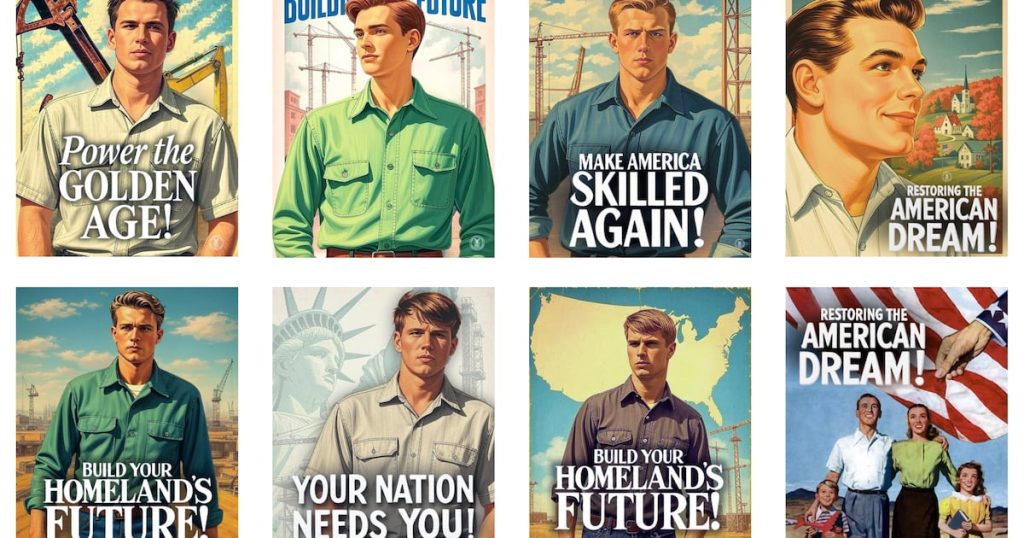Listen to the article
Labor Department’s Nostalgic Ad Campaign Sparks Diversity Concerns
The U.S. Department of Labor’s latest advertising campaign has raised eyebrows for its distinctly vintage aesthetic that critics say fails to represent modern America. Launched in September, “Project Firewall” aims to discourage employers from abusing the visa process for skilled workers, but the campaign’s imagery has become a talking point for reasons beyond its intended message.
The campaign features numerous posters evoking the 1950s era – strikingly Caucasian, idealistic, and reminiscent of post-World War II America. One poster depicts a stereotypical white-gloved family with a lantern-jawed father, church-going mother, and two children posed against an American flag backdrop. The family portrait is captioned with the headline “A dream worth fighting for.”
Another poster shows a family walking hand-in-hand toward a Cape Cod-style home with a smoke-belching factory in the background. The father is dressed in dungarees, apparently after a day’s work. The poster’s message, displayed in all-caps, urges viewers to “RESTORE THE AMERICAN DREAM.”
The Labor Department’s campaign doesn’t stop there. Additional posters feature heroic-looking men with rolled sleeves staring intensely at machinery, carrying cranes, and feeding heavy equipment. These images come with slogans like “The Golden Age of Power!” and “Americans First.”
The Trump administration’s position is clear: American jobs should go to American workers. Employers often counter this argument by claiming there simply aren’t enough skilled American workers available, suggesting that too many Americans are distracted by foreign-made electronic devices instead of studying science and mathematics.
However, the campaign’s nostalgic approach has been criticized for its lack of diversity in a nation where approximately 40% of Americans are not white. When shown the posters, Wilson Eberhart, a 16-year-old Black student at Gwinnett Technical College in Georgia, smiled but acknowledged the disconnect. “It’s stereotypical,” he said. “It looks like it’s trying to go back to another era; it’s hard to get past that fear.”
The imagery stands in stark contrast to the actual demographics of technical colleges where many Americans are training for skilled careers. Gwinnett Technical College’s enrollment in 2024 shows significant diversity: 39% Black, 24% Hispanic, 23% white, 9% Asian, and 4% other ethnicities. During a recent tour of the campus, students of various backgrounds expressed optimism about their futures in technical fields.
Jeffrey Bustillo, a 25-year-old Honduran immigrant and sophomore studying business management, plans to take over the painting business his father started years ago. “I’m trying to learn how businesses work, the laws they need to abide by,” Bustillo said. “The students here are optimistic — they’re trying to get ahead.”
Labor Secretary Lori Chavez-DeRemer, who has been described as a “mainstream” and “sensible” Republican, toured Gwinnett Technical College in September alongside Kelly Loeffler, who now heads the Small Business Administration. Despite the Secretary’s Mexican-American heritage, the department’s promotional materials fail to reflect the diversity she represents.
Critics have compared the aesthetic to Norman Rockwell paintings or even Soviet-style propaganda, though without the Cyrillic lettering. The campaign appears deliberately crafted to evoke a return to a storied American past, with some suggesting it carries an intentional anti-diversity message aligned with broader Trump administration initiatives.
When approached for comment, the Labor Department did not address questions about the lack of diversity in the campaign materials.
As America continues to evolve, the disconnect between the nostalgic imagery of the Labor Department’s campaign and the diverse reality of today’s workforce remains evident. For students like Eberhart and Bustillo, the focus remains not on promotional materials but on the opportunities that technical education provides – regardless of how they’re represented in government advertising.
Verify This Yourself
Use these professional tools to fact-check and investigate claims independently
Reverse Image Search
Check if this image has been used elsewhere or in different contexts
Ask Our AI About This Claim
Get instant answers with web-powered AI analysis
Related Fact-Checks
See what other fact-checkers have said about similar claims
Want More Verification Tools?
Access our full suite of professional disinformation monitoring and investigation tools



